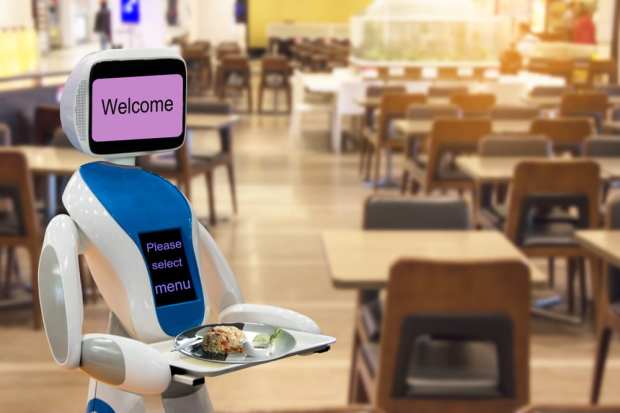Imitation Meat, Loyalty On Demand And Remote Ordering: The Shape-Shifting Of Dining In 2019

As is usually the case, there was plenty to see – and even more to eat – in the national restaurant show this week. During the early part of the week, 43,000 attendees descended on Chicago’s McCormick Place to feast on food samples, experiment with new cooking technology and wander among tables at an exhibition the size of 22 football fields, trying to get a taste for what’s next in in the industry.
And as always, there were some surprisingly big showings at the National Restaurant Show. In 2019, plant-based meats were the show stealer. Though they are historically associated with “hamburgers” that bore more than a passing resemblance to cardboard hockey pucks in both appearance and execution, the last 12 months have marked something of a meatless meat renaissance.
The team at Impossible Foods, which notched a $2 billion valuation early this year, took the opportunity at the show to tout their newly reformulated vegan burger, which reportedly blew viewers away with “how closely it mimicked beef.”
And while meatless meats and their apparent advances were the surprise stars of the show this year, the trend has been notably been building all year. Beyond Burger, an Impossible Foods competitor, is eyeing an IPO, while Don Lee Farms (maker of the veggie burger that bleeds) has been pushing global expansion.
“No one wants to eat a burger hidden with artificial or modified ingredients if they have the choice,” Danny Goodman of Don Lee Farms told PYMNTS earlier this year. “They want natural. They want organic. They want real.”
Or, at least it seems, they want it to taste as real as possible.
The most controversial food item of the day, incidentally, was Jimmy Dean’s sausage gravy stuffed hash brown, which was lovingly described as “meat and cream-filled toaster strudel made of crisp potatoes.” Its flavor is “exactly what you think” – which we assume means it tastes like a heart attack. It was a winner of the 2019 Food and Beverage Award in innovation – an award recognizing “industry-altering products that will shape the future of food and beverage.”
And while it makes sense that a restaurant industry event would focus on the food at the front of the house when handing out awards for innovations, the technical products running behind the scenes are increasingly creeping into the spotlight when it comes to being “industry-altering.”
The ongoing tension between restaurateurs and mobile delivery aggregators like Uber Eats, Grubhub and Deliveroo seems to continue as a powerful product driver. As Olo CEO Noah Glass noted in a conversation earlier this year, restaurant operators wrongly assumed they couldn’t be digitally disrupted because of the nature of what they sold. But, as Karen Webster explained, restaurants are in trouble today, because those third-party order aggregating plays have all matured into real threats to their customers’ loyalty.
“Restaurants sign on because they see it as a way to get orders, even though they run the risk of losing consumer loyalty to their brand, and perhaps even the consumer herself, as aggregators inevitably pivot their platforms – and their platform economics – to create their own branded food experiences,” Webster wrote.
But, as the latest edition of the Restaurant Readiness Index clearly indicates, there is no going back and hitting reset on this for restaurateurs, because customers are pushing for that simplified digital moderated checkout experience. By the numbers, nearly all (92 percent) report that using an app to place a QSR order is a positive experience.
Among offerings that drew attention this week in Chicago was Say2eat, a Messenger-based ordering solution that allows customers to order meals through Facebook Messenger. Designed as an alternative to mobile apps, Say2eat currently counts 168 million customers as users. Synk, on the other hand, is designed to provide a lower-cost alternative to third-party delivery. Using Google mapping, the software optimizes routes for delivery drivers so restaurants can keep their delivery operations in-house.
Gaining strength, but largely off the beaten path this year, were loyalty applications and offerings. According to the Restaurant Readiness Index, nearly eight in 10 QSR customers see loyalty programs as highly important, a view shared by about half of all managers.
Overall, the report found that approximately 80 percent of customers and managers have a positive view of loyalty programs. Among the more successful users of them are Starbucks and Dunkin’, which noted in their most recent earnings reports that they are critical to boosting sales and engagement – particularly when wedded to a mobile order-ahead program.
But at the big show for restaurants nationwide this week, loyalty didn’t get much love or big announcements.
There were, however, robots – specifically, serving bots. Introduced by Bear Robotics, Penny is a self-driving robot designed to deliver food and drink orders and bus tables. Swappable trays allow for different functions, and multiple Penny units can be programmed to work in a small space at once without issue. And then there is Sally, a bot that makes customizable salads, yogurt bowls, grain bowls and snacks using sophisticated robotics and algorithms to dispense accurate portions of hundreds of different ingredients.
Useful – but can it accept an order on the go? Offer points? Make a veggie burger that really tastes like the real thing? Stuff a potato hot pocket with sausage gravy?
Probably not, but then, there is always next year.
